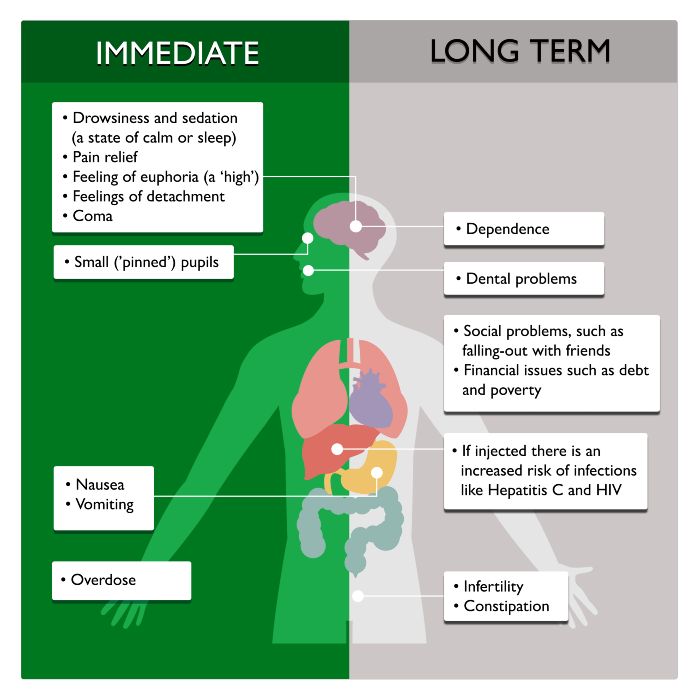What is Heroin?
Heroin is also known as hammer, gear, or smack.
Heroin is one of a group of drugs known as opiates. They are natural products of the opium poppy and also include opium, morphine, and codeine. For more information, see What are opioids?
In Australia, heroin can be a fine powder, granules or rocks. It is normally white or off-white in colour, although it is sometimes brown. It is normally injected, but is also snorted, smoked, or heated and the vapours inhaled (chasing the dragon). It can be sold ‘cut’ (mixed) with a range of substances that can also be harmful. This makes it hard for the user to know the purity of what’s being taken.
Heroin is considered to be the second most addictive drug after tobacco.
How many young people have tried Heroin?According to the 2022-2023 Australian secondary schools' survey, 1 in 500 students (0.2%) aged 12-17 used heroin in the past month.
What are the effects of Heroin?Heroin produces a ‘rush’ within seconds of injecting or smoking it. If snorted, it takes about 5 minutes to feel the effects. The effects of heroin can last for approximately 3–5 hours.
The effects of heroin can be immediate or long-term, as listed in the table below.
| Immediate |
Long-term |
| Small (‘pinned’) pupils |
Dependence (see glossary) |
| Drowsiness and sedation (a state of calm or sleep) |
Dental problems |
| Pain relief |
Constipation |
| Feeling of euphoria (a ‘high’) |
If injected there is an increased risk of infections like Hepatitis C and HIV |
| Feelings of detachment |
Infertility |
| Nausea and vomiting |
Social problems, such as falling-out with friends |
| Overdose |
Financial issues such as debt and poverty |
| Coma |
|

Evidence BaseThis factsheet was developed following expert review by researchers at the Matilda Centre for Research in Mental Health and Substance Use at the University of Sydney, the National Drug & Alcohol Research Centre at the University of New South Wales, and the National Drug Research Institute at Curtin University.
- Scully, M., Koh, I., Bain, E., Wakefield, M., & Durkin, S. (2023). ASSAD 2022–2023: Australian secondary school students’ use of alcohol and other substances. Cancer Council Victoria.
- Stafford, J. and Burns, L., 2012. Australian Drug Trends 2011. Findings from the Illicit Drug Reporting System (IDRS). Australian
Drug Trend Series No. 73 National Drug and Alcohol Research Centre, University of New South Wales: Sydney.
- Sindicich, N. and Burns, L., 2012. Australian Trends in Ecstasy and related Drug Markets 2011. Findings from the Ecstasy and
Related Drugs Reporting System (EDRS). Australian Drug Trend Series No. 82. , National Drug and Alcohol Research Centre,
University of New South Wales: Sydney.
- Alcohol and other Drugs Council of Australia, 2011. Tips and tricks for new players 3rd ed, ADCA: Woden ACT.
- Darke, S., 2011. The life of the heroin user: Typical beginnings, trajectories and outcomes, Cambridge: Cambridge University
Press.
- Cone, E., 1998. Recent discoveries in pharmacokinetics of drugs of abuse. Toxicology Letters. 102-103: p. 97-101.
- NSW Health, 2008. Drug and Alcohol Withdrawal Clinical Practice Guidelines - NSW, Sydney: NSW Health.
- Iversen, J. and Maher, L., 2012. Australian Needle and Syringe Program National Data Report 2007-2011. , The Kirby Institute,
University of New South Wales: Sydney.
- Pfaus JG, G.B., 1987. Opioids and sexual behavior. Neuroscience and Biobehavioral Reviews. 11: p. 1–34.
- Australian Crime Commission, 2012. Illicit Drug Data Report 2010-11, Australian Crime Commission: Canberra.
- American Psychiatric Association, 2000. Diagnostic and statistical manual of mental health disorders, fourth edition, text
revision, Washington, DC: American Psychiatric Association.